The options for interfacing frequency-modulated (FM) equipment with cochlear implants (CIs) are increasing with the development of new implant features and new FM options. Because traditional methods of evaluation through informal listening checks or electroacoustic measures are typically not possible with CIs, one must ensure optimal connections and settings through systematic speech recognition measures. A protocol for verification of an FM fitting with a CI may involve informal and formal behavioral evaluations. Although informal measures are necessary to verify functioning of the local and remote microphones, more objective measurements are needed to compare different settings within an arrangement or the speech recognition benefits across different types of FM systems.
The benefits provided by FM systems to school-age children who use CIs can be determined through speech recognition testing (Davies, Yellon, and Purdy, 2001; Schafer and Thibodeau, 2003). Children with CIs may obtain an average increase in speech recognition in noise of 30% in a simulated classroom when using FM systems (Schafer and Thibodeau, 2003). However, the simulated classroom setup is not feasible in a clinic setting where FM systems may be dispensed to children with CIs. Therefore, the test setup for verification of FM systems recommended by the ASHA taskforce in 2002 may be used (ASHA, 2002). Ideally, speech recognition is measured in the soundfield while a child wears the CI speech processor alone and then while wearing the speech processor combined with the FM receiver. The benefit provided by the FM system in this clinical arrangement may be used as a guide for comparing FM system arrangements.
Because there are many styles of speech processors and FM receiver arrangements, the options for the signal levels are numerous. For example, the sensitivity of the microphone of the speech processor may be varied on the Cochlear ESPrit 3G if the external dial setting is programmed for sensitivity rather than volume. When the sensitivity is increased, directionality is minimized. In other words, the environmental signal near the child will be increased relative to the teacher's voice from the FM transmitter microphone. If set too high, the intent of improving the signal-to-noise ratio (SNR) for the child may not be realized. There are also settings on the FM receivers that allow for manipulation of the FM advantage, or increase of the target signal from the transmitter microphone above that of the CI microphone alone. As shown in Figure 1, some are manually controlled such as the Phonak MLCI+ receiver, while others are digitally controlled, such as the Oticon Amigo and Phonak MLxS.
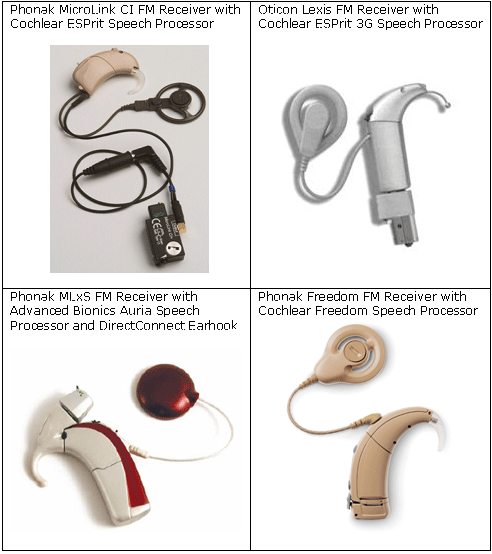
Figure 1. FM Receivers coupled to Cochlear Implant Speech Processors.
The purpose of this discussion is to review a two-step protocol for verification of speech recognition benefit when using FM systems coupled to CIs. The first step is to verify that the equipment is functioning and connected properly through informal measures. This procedure may also be used as the daily check in the classroom to ensure proper equipment functionality. The next step is to evaluate speech recognition in noise with and without the FM system to confirm that the settings on both the CI and FM receiver are optimal.
Preassessment Verification
Prior to any listening attempts either by the examiner or the child, proper equipment arrangements must be confirmed by consulting information provided by the manufacturer of the implant and of the FM system. Each company provides information on their website regarding the FM to CI connections. To assist with recording the possible arrangements and settings, a form is provided in Figure 2. Because there are numerous options currently available, and with many children now receiving bilateral implants from possibly even different manufacturers, a separate form from the audiogram is needed to record the FM/CI arrangement, model information, and behavioral results. In addition, settings including volume/sensitivity, speech processor program, and the FM receiver adjustments should be recorded. Ideally, information regarding the implant should be obtained from the audiologist who does the mapping of the speech processor.
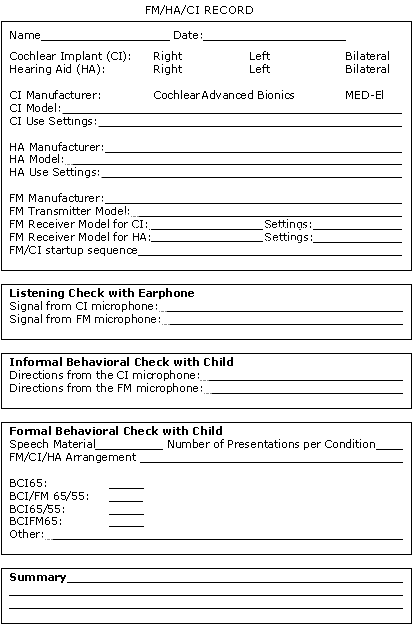
Figure 2. Behavioral Evaluation of FM/CI System
Download a customizable copy of the FM Verification Form from Figure 2 in MS Word format.
The startup sequence recommended by the manufacturer should also be recorded. While all the units are in the off position, the FM receiver should be connected to the CI. In most cases, the CI is turned on first followed by the FM receiver (if necessary), and finally the FM transmitter. However, there are some exceptions to this sequence and deviations from the recommendations could result in malfunction or absence of the FM signal.
Contact Information for FM/CI Manufacturers
For Cochlear Implants by:
Cochlear (800-523-5798):www.cochlearamericas.com
Advanced Bionics (800-678-2575):www.bionicear.com
MED-EL (888-633-3524):www.medel.com
For FM Systems by:
Phonak (800-679-4871):www.phonak.com
Oticon (800-526-3921):www.oticonus.com
Sonovation (800-462-8336):www.avrsono.com
Comtek (800-469-3463):www.comtek.com
Phonic Ear: www.phonicear.com
Lexis: www.lexisfm.net/
Informal Assessment
After consulting the information provided by the manufacturers regarding appropriate connections, there are two steps to the informal assessment that involve first, just the audiologist and second, the audiologist working with the student. Initially, the audiologist will want to verify that acoustic signals are received through both the local microphone on the CI speech processor and through the FM transmitter microphone. Some speech processors allow checking these signals through the use of a listening earphone. For the Cochlear SPRINT and Freedom body-worn processors and Cochlear ESPrit 3G and Freedom ear-level processor, the listening earphone can be attached at the same time as the FM receiver. Through this listening earphone the signals from the FM and processor microphones can be verified. Typically, one may tap each microphone separately to determine that both signals are received at the speech processor.
The verification of the sensitivity or volume control on the Cochlear ESPrit 3G and Freedom speech processors may also be confirmed while listening through the earphone and rotating the dial. On the ESPrit 3G, if the signal increases in volume as the dial is rotated, the speech processor is set for sensitivity. If there is no increase in the signal, then the dial is programmed for volume and rotation of the dial causes an increase in the current levels delivered to the child.
For CI speech processors that do not have separate ports for the FM receiver and for the listening earphone, the examiner will need to verify the FM equipment coupled with another device such as a hearing aid. Knowing that the FM receiver is functioning prior to connection to the CI will facilitate troubleshooting. The functionality of some FM receivers such as the Phonak MLCI+ and the Sonovation Logicom can be verified through the use of a small speaker as show in Figure 3. When the signal from the FM microphone is heard through the connection of the MLCI+ to the speaker, several components are verified including the battery in the MLCI+, the volume setting, the connector cord, and the FM receiver channel.
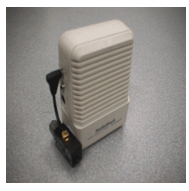
Figure 3. Illustration of the use of a small speaker (Radio Shack Cat. No. 277-1008C) to verify output from the FM receiver for a Phonak MLCI+.
Even after the audiologist confirms that the signals are received appropriately, the second step in the informal assessment is to verify the arrangement on the child prior to the formal assessment. A common listening check arrangement for CI/FM verification is to put the combined CI/FM devices and present simple directions while standing in front of the child. However, if the child responds correctly, it is not known if both the local microphone on the CI and the FM microphone were working. Furthermore, if a child wears bilateral processors, it is tempting to get all the CI/FM devices in place and present simple speech while standing in front of the child. When the child responds, it is unknown if each speech processor was functioning.
If the child wears bilateral CIs or CI plus HA, each side should be verified separately. There are two steps for each verification: one is to confirm the child receives input from the local CI microphone and the second is to confirm the child receives input from the FM microphone. The CI microphone typically remains active while the FM system is connected. One exception is with the Advanced Bionics body-worn Platinum Processor. With this speech processor, a microphone must be added to the FM receiver that is worn by the child so that he/she can self-monitor and hear the signals nearby.
After placing the first side of equipment on the child, typically the first CI plus FM, the activation of the local microphone is verified while the FM system is set to typical-use settings. The FM microphone should be placed across the room where there is no direct input while the examiner gives simple directions to the child from directly behind him/her. For older children, a more challenging task may be used with limited predictability such as naming the capitol or a sports team associated with the state named by the examiner. For younger children, speech awareness may be verified using play audiometry techniques.
Following verification of the local microphone, the examiner should walk across the room and repeat the informal speech recognition task while speaking into the FM microphone. It is important to be far enough away that the child does not hear through the CI local microphone. In addition, no visual speech recognition cues should be available so that the responses from the child can be interpreted as verification of the signals received through the CI/FM system. The same measures should be followed for the second-side arrangement.
Formal Assessment
After the equipment has been placed on the child and verified informally, a formal assessment of benefit can be performed to ensure the proper settings. The purpose of this formal assessment is to compare performance with the CI alone to that with the CI plus the FM. Appropriate speech materials for the child's age that supply multiple lists must be selected. Typically, background noise is added to degrade the performance with the CI alone so that the benefit of using the FM system may be observed. The noise may be speech-weighted noise or classroom noise.
Classroom noise is available under the audio demonstrations section of the Educational Resources for Reducing Interference in Noisy Groups (EARRING) CD ROM which is available a www.utdallas.edu/~thib
The test arrangement recommend by the ASHA (2002) Guidelines for Evaluation of FM Systems is shown in Figure 4. The child is seated in the soundbooth facing the loudspeaker at one-meter's distance with all equipment in place and activated. The examiner is seated facing the audiometer wearing the FM transmitter, but it is in the off position. In order to examine the benefits of a signal presented into the FM transmitter, the examiner must present the speech via monitored live voice while wearing the microphone. Although this adds to the test variability compared to using recorded materials, the benefit received through the use of the transmitter is typically several times greater than the possible variability. Because the testing uses monitored live voice at a fixed presentation level, the result will be a percent correct score.
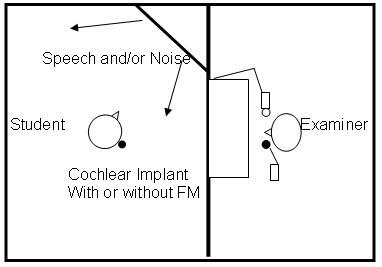
Figure 4. Testing arrangement according to the 2002 ASHA Guidelines for Fitting and Monitoring FM Systems (ASHA, 2002).
The recommended signal level is 55 dB HL with speech noise presented at 50 dB HL. Both signals can be presented from the same speaker. The designator for this behavioral test arrangement without the FM transmitter activated is BCI55/50. The first letter refers to the type of testing, B for Behavioral in this case. The next letters refer to the equipment used in the test condition, CI for cochlear implant and FM for frequency-modulated receiver. The first number in the designator always refers to the signal level, while a second number indicates there is noise presented at that level. Although not stated in the ASHA guidelines, it is important to note that if the initial performance equals or exceeds 80% correct, then the noise must be increased to a 0 dB SNR and another list presented.
Following the assessment of the performance for BCI55/50, the next measure is made with the FM transmitter activated while the signal and noise levels remain the same. If a 0 SNR was needed to reduce performance in the CI condition, the benefit of adding the FM system is tested in that same 0 SNR. If time permits, it is suggested in the ASHA (2002) guideline that the measures be repeated in quiet (BCI55 and BCIFM55) to ensure that adding the FM system does not decrease the signal levels through distortion or intensity reduction.
The results of this verification protocol with 8 students with CIs, mean age 7.88 years, conducted by Thibodeau et al. (2005) are shown in Figure 5. There were a variety of CIs and FM systems worn by the 8 students who were evaluated at their user settings. The average speech recognition for single words presented in speech noise at +5 SNR was 45.5%. With the use of the FM system, the performance improved to an average of 76% correct. All of the students showed improved performance with the FM system with the 95% confidence interval ranging from 13 to 47%. As expected, the lower the performance in noise without the FM, the greater the benefit that was observed with the FM system. Although the sample size was small, one may consider the low end of the 95% confidence interval (13%) as an estimate of the minimal improvement expected when an FM system is used with a CI. It should be noted that this guideline is based on a sample of children who were tested at user settings without the benefits of any fine tuning to CI or FM settings.
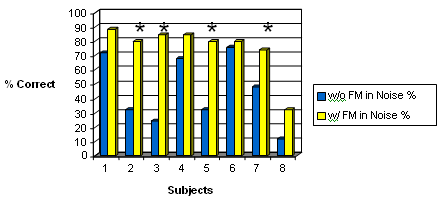
Figure 5. Individual scores for children with a cochlear implant, tested in noise, with and without an FM system. An asterisk marks those with significant improvements re: Thornton and Raffin (1988).
Note. Figure adapted from Thibodeau et al. (2005).
If the protocol is followed and the improvement with the FM system is less than 13%, then changes to the FM receiver settings or the FM device arrangement should be considered. For example, with the Phonak MLxS miniature "cube-like" FM receiver, changes to the FM advantage may be made through programming software while the CI/FM receiver is turned on and placed in an FM Programming Interface. Figure 6 shows the Phonak Programming Interface being used with a hearing aid and the FM Successware programming software.
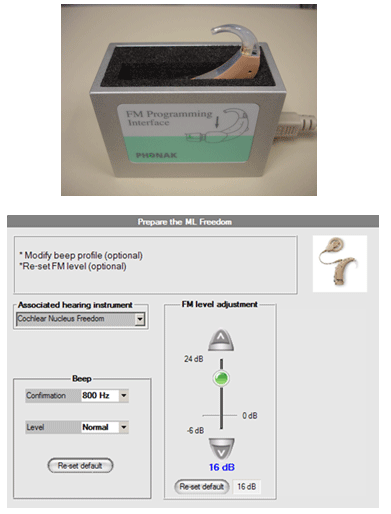
Figure 6. Top: Use of an FM Programming Interface to adjust the level of the FM signal for a Phonak FM Receiver coupled to a hearing aid. Bottom: Screenshot from FM Successware programming software by Phonak, showing the adjustment of the FM advantage for a Cochlear Freedom FM receiver.
One limitation to the protocol is the use of a percent correct measure which has high variability. For the typical speech recognition list of 25 words, a 20% difference is the minimum change needed for significance if the initial score without the FM system is between 16 and 80% (Thornton and Raffin, 1978). Schafer and Thibodeau (2006) considered the use of an adaptive speech recognition protocol for children involving a doll and simple phrases such as "brush his teeth" and "comb his hair." They showed an average 13 dB improvement in speech recognition threshold in noise when FM input was added to a single CI. An additional 3 dB improvement on average was observed when FM input was bilateral relative to monaural. In terms of percent correct scoring, this translates to approximately a 30% increase when adding the FM signal to the second side.
Another limitation to the formal assessment modeled after the ASHA (2002) guidelines is that the student must be capable of giving some consistent response to speech. Just as with routine audiological procedures, adaptations to testing routines may be necessary and should always be noted in the records. For example, for a very young child, a list of body parts may be presented in each condition, CI alone and then CI+FM. Although this involves a closed-set and the probability for guessing is higher than for a longer list of open-set materials, it can be a first step in verifying that the child is performing better with the CI+FM than the CI alone. In cases where speech awareness is a more reliable measure than speech recognition, the test arrangement suggested in Figure 4 may still be used. Rather than measuring the percentage of words correctly repeated, the level at which the examiner's voice may be detected in the presence of 50 dB HL speech noise may be determined first with the CI alone, followed by the CI+FM arrangement. The level for speech awareness should be lower with the CI+FM arrangement compared to the CI alone. Although true for all CI+FM fittings, it is especially critical to follow-up with classroom observations to ensure the child is responding to signals that are presented through the FM transmitter.
Summary
Children with CIs can receive significant benefit in speech recognition through the use of an FM system in noisy environments (Davies, Yellon, and Purdy, 2001; Schafer and Thibodeau, 2003, 2006). However, there are numerous settings as well as equipment arrangements that may be selected for a child. Therefore, a clinical protocol is needed for verification of performance to determine the optimum settings and arrangement. The ASHA (2002) Guidelines for the Fitting and Monitoring of FM Systems provides a protocol for behavioral evaluation of FM systems with hearing aids. This protocol was expanded to include informal listening checks of the CI with the FM system and then evaluation with students. Thibodeau et al. (2005) used this expanded protocol and found an average improvement in percent correct score when using the FM system with the CI was 30% better than the CI alone condition. Although an adaptive speech recognition procedure may be more sensitive, initial results with the expanded ASHA (2002) protocol suggest that it may be used to behaviorally verify benefit received when coupling FM systems to CIs.
Acknowledgements
The equipment contributions by Phonak and Cochlear Corporation for several research projects is gratefully acknowledged. Gratitude is also expressed to Erin Schafer for the contribution of the classroom noise.
References
American Speech-Language-Hearing Association. (2002). Guidelines for fitting and monitoring FM Systems. ASHA Desk Reference, 2, 151-171.
Davies, M., Yellon, L., and Purdy, S. (2001). Speech in noise perception of children using cochlear implants and FM systems. The Australian and New Zealand Journal of Audiology, 23, 52-62.
Schafer, E. and Thibodeau, L. (2003). Speech recognition performance of children using cochlear implants and FM systems. Journal of Educational Audiology, 11, 15-26.
Schafer, E. and Thibodeau, L. (2006). Speech recognition in noise in children with cochlear implants while listening in bilateral, bimodal, and FM-system arrangements. American Journal of Audiology. In Press.
Thibodeau, L., Schafer, E., Overson, G., Whalen, H., and Sullivan, J. (2005) Clinical evaluation of the benefits provided by FM systems directly connected to cochlear implants 10th Symposium on Cochlear Implants in Children. Dallas, TX.
Thornton, A. and Raffin, M.J.M. (1978). Speech discrimination scores modified as a binomial variable. Journal of Speech and Hearing Research, 21, 507-518.


